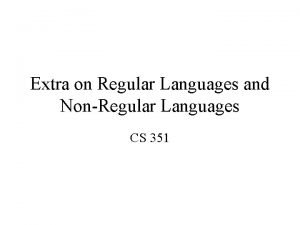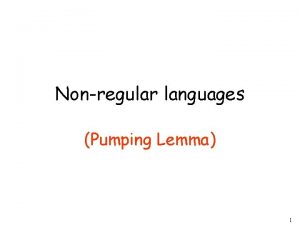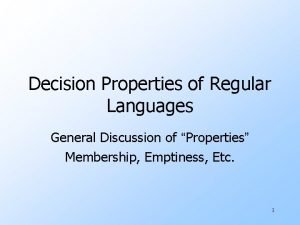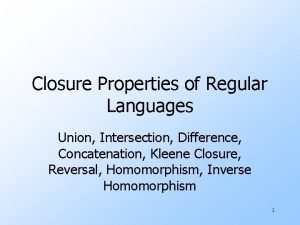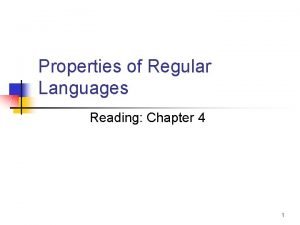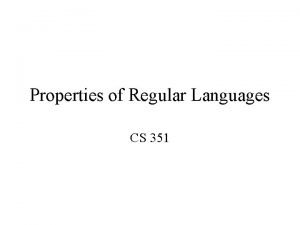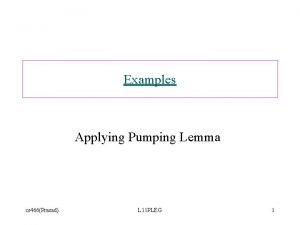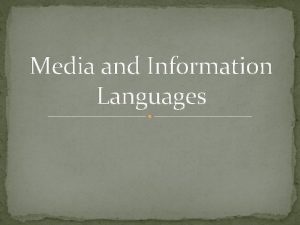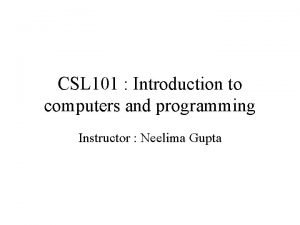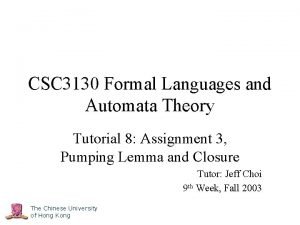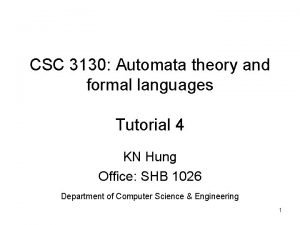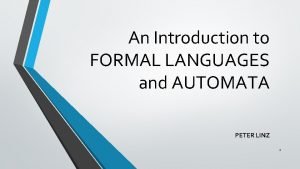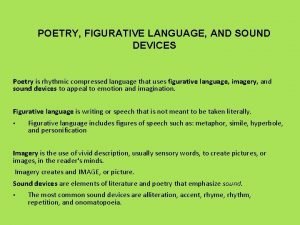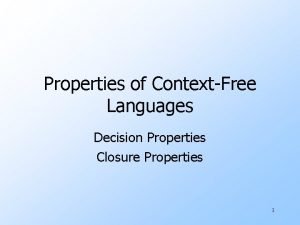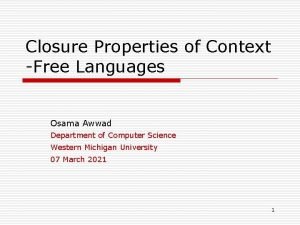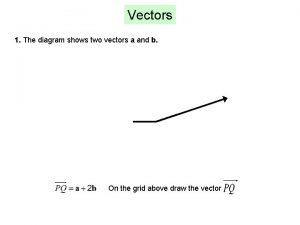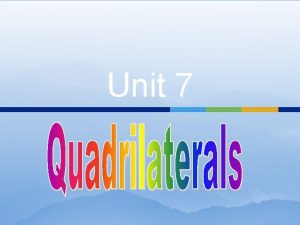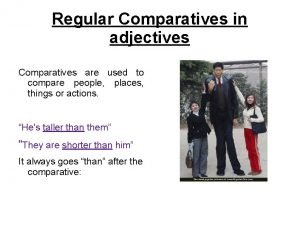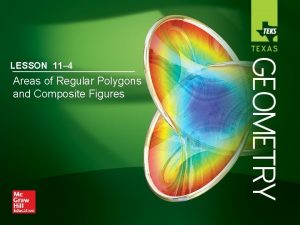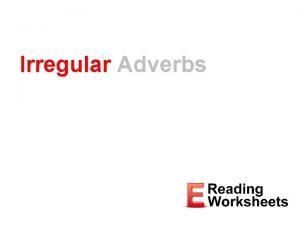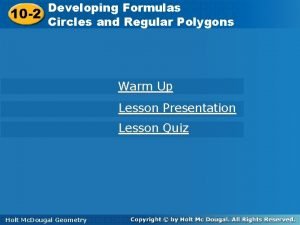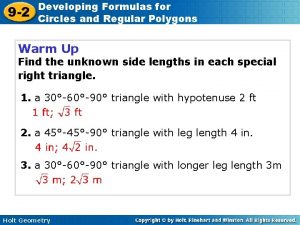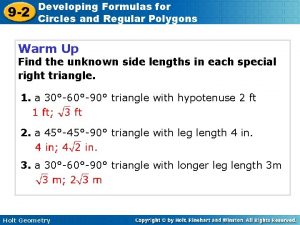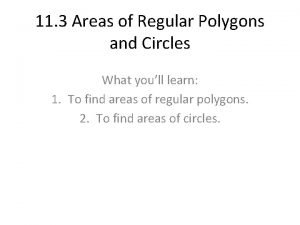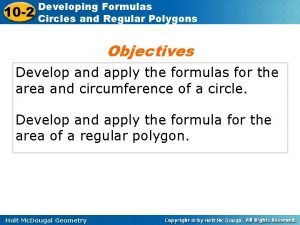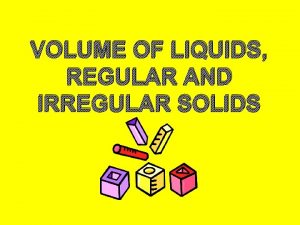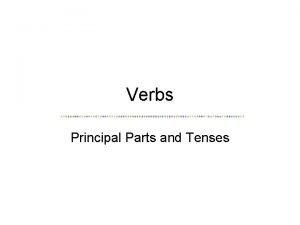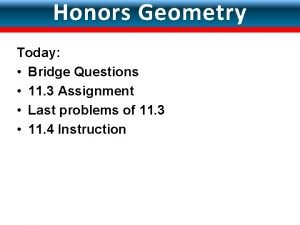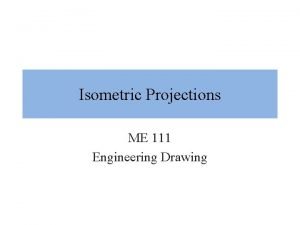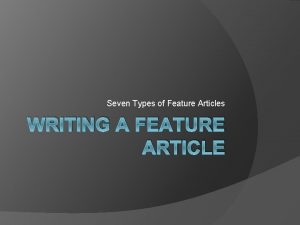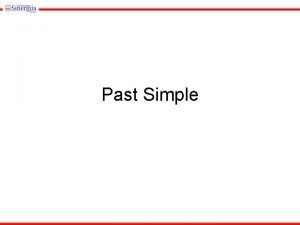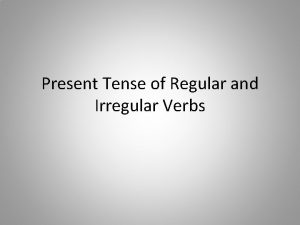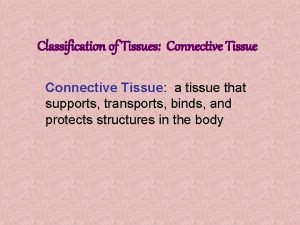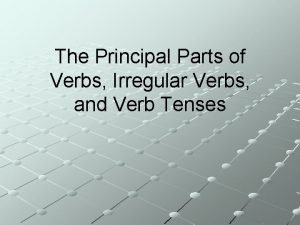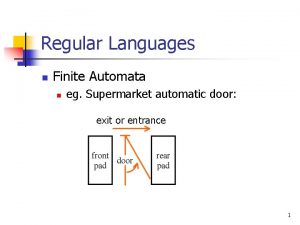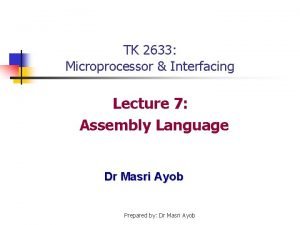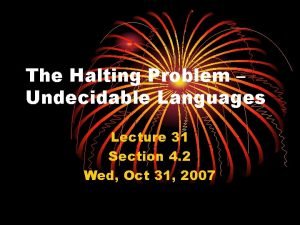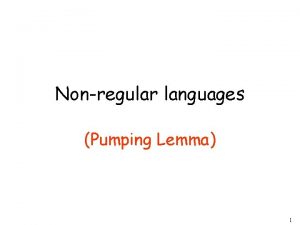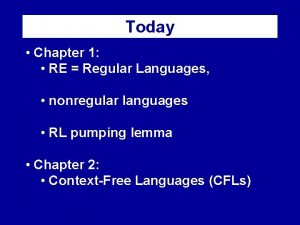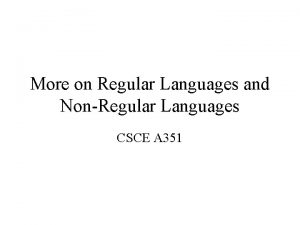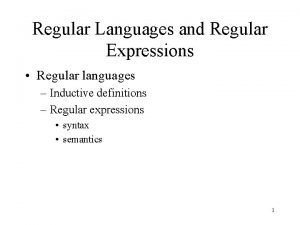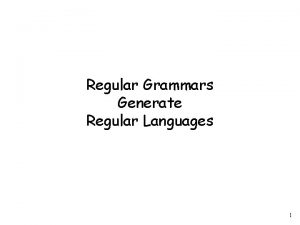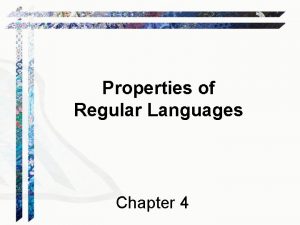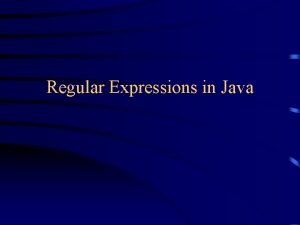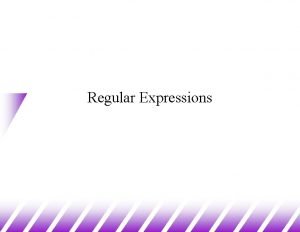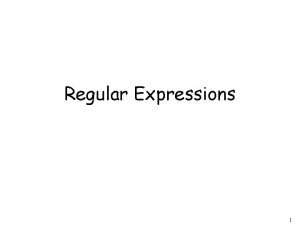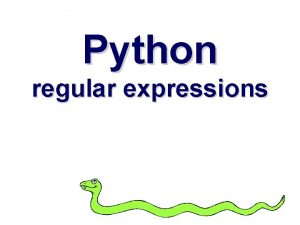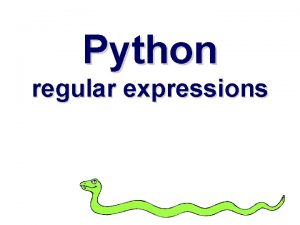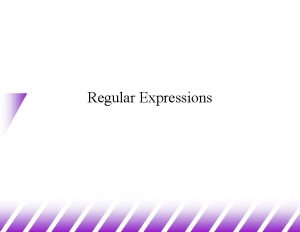Regular and Nonregular Languages Chapter 8 1 Languages





































































- Slides: 69

Regular and Nonregular Languages Chapter 8 1

Languages: Regular or Not? a*b* is regular. {anbn: n 0} is not. {w {a, b}* : every a is immediately followed by b} is regular. {w {a, b}* : every a has a matching b somewhere} is not ● Showing that a language is regular. ● Showing that a language is not regular. 2

How Many Regular Languages? Theorem: There is a countably infinite number of regular languages. Proof: ● Upper bound on number of regular languages: number of FSMs (or regular expressions). ● Lower bound on number of regular languages: {a}, {aaa}, {aaaaa}, {aaaaaa}, … are all regular. That set is countably infinite. 3

Regular And Nonregular Languages? There is a countably infinite number of regular languages. There is an uncountably infinite number of languages over any nonempty alphabet . So there are many more nonregular languages than there are regular ones. 4

Showing that a Language is Regular Theorem: Every finite language is regular. Proof: If L is the empty set, then it is defined by the regular expression and so is regular. If it is any finite language composed of the strings s 1, s 2, … sn for some positive integer n, then it is defined by the regular expression: s 1 s 2 … sn So it too is regular. 5

Showing that a Language is Regular Example: Let L = L 1 L 2, where: L 1 = {anbn, n 0}, and L 2 = {bnan, n 0} L= Is L 1 regular? Is L 2 regular? Is L regular? 6

Finiteness - Theoretical vs. Practical Any finite language is regular. The size of the language doesn't matter. Parity Checking Soc. Sec. # Checking But, from an implementation point of view, it very well may. When is an FSM a good way to encode the facts about a language? FSM’s are good at looking for repeating patterns. They don't bring much to the table when the language is just a set of unrelated strings. 7

Regular Does Not Always Mean Tractable Let = {12, 13, 21, 23, 31, 32}. Let L be the language of strings that correspond to successful move sequences. The shortest string in L has length 264 -1. There is an FSM that accepts L: 8

Showing That L is Regular 1. Show that L is finite. 2. Exhibit an FSM for L. 3. Exhibit a regular expression for L. 4. Show that the number of equivalence classes of L is finite. 5. Exhibit a regular grammar for L. 6. Exploit the closure theorems. 9

Closure Properties of Regular Languages ● Union ● Concatenation ● Kleene Proved by same constructions used in the proof of Kleene’s Theorem star ● Complement ● Intersection ● Difference ● Reverse ● Letter substitution 10

Closure of Regular Languages Under Complement 11

Closure of Regular Languages Under Complement What about: a b On input bbb? 12

Closure of Regular Languages Under Complement What about: a a On input a? 13

A Complement Example 14

The Complement Procedure Given: an FSM M, Construct a new machine to accept L(M): • If necessary, use ndfsmtodfsm to construct M , a deterministic equivalent of M. • Make sure that M is described completely. • Swap accepting and nonaccepting states. 15

Closure of Regular Languages Under Intersection L 1 L 2 = L 1 L 2 Write this in terms of operations we have already proved closure for: ● Union ● Concatenation ● Kleene star ● Complementation 16

Closure of Regular Languages Under Intersection L 1 L 2 = ( L 1 L 2) L 1 L 2 Since L 1 is regular, L 1 is regular. Since L 2 is regular, L 2 is regular. L 1 L 2 is regular. L 1 L 2 = ( L 1 L 2) is regular. 17

Closure of Regular Languages Under Difference L 1 - L 2 = 18

Closure of Regular Languages Under Difference L 1 - L 2 = L 1 L 2 Since L 2 is regular, L 2 is regular. Since both L 1 and L 2 are regular, L 1 - L 2 = L 1 L 2 is regular. 19

Letter Substitution ● Let 1 and 2 be alphabets. ● Let sub be any function from 1 to 2*. Example: Let: 1 = {a, b}, 2 = {0, 1}, sub(a) = 0, and sub(b) = 11. 20

Letter Substitution letsub is a letter substitution function iff: letsub(L 1) = {w 2* : y L 1 and w = y except that: every character c of y is replaced by sub(c)}. Example: sub(a) = 0, and sub(b) = 11. Then letsub({anbn, n 0}) = 21

Divide-and-Conquer Let L = {w {a, b}* : w contains an even number of a’s and an odd number of b’s and all a’s come in runs of three}. L = L 1 L 2, where: • L 1 = {w {a, b}* : w contains an even number of a’s and an odd number of b’s}, and • L 2 = {w {a, b}* : all a’s come in runs of three} 22

L 1 is Regular 23

L 2 is Regular Since both L 1 and L 2 are regular, L = L 1 L 2 is regular. 24

Don’t Try to Use Closure Backwards One Closure Theorem: If L 1 and L 2 are regular, then so is L = L 1 L 2 But if L is regular, what can we say about L 1 and L 2? L = L 1 L 2 25

Don’t Try to Use Closure Backwards One Closure Theorem: If L 1 and L 2 are regular, then so is L = L 1 L 2 But if L is regular, what can we say about L 1 and L 2? L = L 1 L 2 ab = ab (a b)* (they are regular) 26

Don’t Try to Use Closure Backwards One Closure Theorem: If L 1 and L 2 are regular, then so is L = L 1 L 2 But if L is regular, what can we say about L 1 and L 2? L = L 1 L 2 ab = ab (a b)* (they are regular) ab = ab {anbn, n 0} (they may not be regular) 27

Don’t Try to Use Closure Backwards Another Closure Theorem: If L 1 and L 2 are regular, then so is L = L 1 L 2 But if L 2 is not regular, what can we say about L? L = L 1 L 2 28

Don’t Try to Use Closure Backwards Another Closure Theorem: If L 1 and L 2 are regular, then so is L = L 1 L 2 But if L 2 is not regular, what can we say about L? L = L 1 L 2 {abanbn : n 0} = {ab} {anbn : n 0} 29

Don’t Try to Use Closure Backwards Another Closure Theorem: If L 1 and L 2 are regular, then so is L = L 1 L 2 But if L 2 is not regular, what can we say about L? L = L 1 Not Regular L 2 {abanbn : n 0} = {ab} {anbn : n 0} Regular {aaa*} = {a*} {ap: p is prime} 30

Showing that a Language is Not Regular Every regular language can be accepted by some FSM. It can only use a finite amount of memory to record essential properties. Example: {anbn, n 0} is not regular 31

Showing that a Language is Not Regular The only way to generate/accept an infinite language with a finite description is to use: • Kleene star (in regular expressions), or • cycles (in automata). This forces some kind of simple repetitive cycle within the strings. Example: ab*a generates aba, abbba, abbbba, etc. Example: {an : n 1 is a prime number} is not regular. 32

How Long a String Can Be Accepted? What is the longest string that a 5 -state FSM can accept? 33

How Long a String Can Be Accepted? What is the longest string that a 5 -state FSM can accept? 34

How Long a String Can Be Accepted? What is the longest string that a 5 -state FSM can accept? 35

Exploiting the Repetitive Property If an FSM with n states accepts any string of length n, how many strings does it accept? L = bab*ab b a b x y z xy*z must be in L. We can pump y out. We can also pump in as many y as we like. . So L includes: baab, babbab, babbbbbab 36

Theorem – Long Strings Theorem: Let M = (K, , , s, A) be any DFSM. If M accepts any string of length |K| or greater, then that string will force M to visit some state more than once (thus traversing at least one loop). Proof: M must start in one of its states. Each time it reads an input character, it visits some state. So, in processing a string of length n, M creates a total of n + 1 state visits. If n+1 > |K|, then, by the pigeonhole principle, some state must get more than one visit. So, if n |K|, then M must visit at least one state more than once. 37

The Pumping Theorem for Regular Languages If L is regular, then every long string in L is pumpable. So, k 1 ( strings w L, where |w| k ( x, y, z (w = xyz, |xy| k, y , and q 0 (xyqz is in L)))). 38

Example: {anbn: n 0} is not Regular k is the number from the Pumping Theorem. Choose w to be a k/2 b k/2 (“long enough”). 1 2 aaaaa…aaaaabbbb …bbbbbb x y z Case III We show that there is no x, y, z with the required properties: |xy| k, y , q 0 (xyqz is in L). Three cases to consider: ● Case I: y falls in region 1: ● Case II: y falls across regions 1 and 2: ● Case III: y falls in region 2: 39

Example: {anbn: n 0} is not Regular k is the number from the Pumping Theorem. Choose w to be a k/2 b k/2 (“long enough”). 1 2 aaaaa…aaaaabbbb …bbbbbb x y z While this works, there is an easier way: 40

Example: {anbn: n 0} is not Regular Second try: Choose w to be akbk (We get to choose any w). 1 2 aaaaa…aaaaabbbb …bbbbbb x y z We show that there is no x, y, z with the required properties: |xy| k, y , q 0 (xyqz is in L). Since |xy| k, y must be in region 1. So y = ap for some p 1. Let q = 2, producing: ak+pbk which L, since it has more a’s than b’s. 41

A Complete Proof We prove that L = {anbn: n 0} is not regular If L were regular, then there would exist some k such that any string w where |w| k must satisfy the conditions of theorem. Let w = a k/2 b k/2. Since |w| k, w must satisfy the conditions of the pumping theorem. So, for some x, y, and z, w = xyz, |xy| k, y , and q 0, xyqz is in L. We show that no such x, y, and z exist. There are 3 cases for where y could occur: We divide w into two regions: aaaaa…. . aaaaaa 1 | bbbbb…. . bbbbbb | 2 So y can fall in: ● (1): y = ap for some p. Since y , p must be greater than 0. Let q = 2. The resulting string is ak+pbk. But this string is not in L, since it has more a’s than b’s. ● (2): y = bp for some p. Since y , p must be greater than 0. Let q = 2. The resulting string is akbk+p. But this string is not in L, since it has more b’s than a’s. ● (1, 2): y = apbr for some non-zero p and r. Let q = 2. The resulting string will have interleaved a’s and b’s, and so is not in L. There exists one long string in L for which no x, y, z exist. So L is not regular.

Using the Pumping Theorem If L is regular, then every “long” string in L is pumpable. To show that L is not regular, we find one that isn’t. To use the Pumping Theorem to show that a language L is not regular, we must: 1. Choose a string w in L, where |w| k. Since we do not know what k is, we must state w in terms of k. 2. Divide the possibilities for y into a set of equivalence classes that can be considered together. 3. For each such class of possible y values where |xy| k and y : Choose a value for q such that xyqz is not in L. 43

Bal = {w {), (}* : the parens are balanced} A w in L can be very complicated, but we only pick one. If we pick (k)k, the proof is similar to the previous example. 44

Pal. Even = {ww. R : w {a, b}*} Again, a w in L can be very complicated, but we only pick one. If we pick akbkbkak, the proof is similar to the previous examples. 45

{anbm: n > m} Sometimes we need to pump out. Let w = ak+1 bk, can we prove by pumping in? Is w = a 2 kbk a good choice? 46

L = {an: n is prime} Let w = aj, where j is the smallest prime number > k+1. y = ap for some p. q 0 (a|x| + |z| +q|y| must be in L). So |x| + |z| +q |y| must be prime. But suppose that q = |x| + |z|. Then: |x| + |z| +q |y| = |x| + |z| + (|x| + |z|) y = (|x| + |z|) (1 + |y|), which is non-prime if both factors are greater than 1: 47

L = {an: n is prime} Let w = aj, where j is the smallest prime number > k+1. y = ap for some p. q 0 (a|x| + |z| +q|y| must be in L). So |x| + |z| +q |y| must be prime. But suppose that q = |x| + |z|. Then: |x| + |z| +q |y| = |x| + |z| + (|x| + |z|) y = (|x| + |z|) (1 + |y|), which is non-prime if both factors are greater than 1: (|x| + |z|) > 1 because |w| > k+1 and |y| k. (1 + |y|) > 1 because |y| > 0. 48

Using the Pumping Theorem Effectively ● To choose w: ● Choose a w that is in the part of L that makes it not regular. ● Choose a w that is only barely in L. ● Choose a w with as homogeneous as possible an initial region of length at least k. ● To choose q: ● Try letting q be either 0 or 2. ● If that doesn’t work, analyze L to see if there is some other specific value that will work. 49

Using the Closure Properties The two most useful ones are closure under: • Intersection • Complement 50

Using the Closure Properties L = {w {a, b}*: #a(w) = #b(w)} If L were regular, then: L = L _______ would also be regular. But it isn’t. 51

L = {aibj: i, j 0 and i j} Try to use the Pumping Theorem by letting w = ak+1 bk: 52

L = {aibj: i, j 0 and i j} Try to use the Pumping Theorem by letting w = akbk+k!. Then y = ap for some nonzero p. Let q = (k!/p) + 1 (i. e. , pump in (k!/p) times). Note that (k!/p) must be an integer because p < k. The number of a’s in the new string is k + (k!/p)p = k + k!. So the new string is ak+k!bk+k!, which has equal numbers of a’s and b’s and so is not in L. 53

L = {aibj: i, j 0 and i j} An easier way: If L is regular then so is L. Is it? 54

L = {aibj: i, j 0 and i j} An easier way: If L is regular then so is L. Is it? L = {anbn: n 0} {out of order} If L is regular, then so is L = L a*b* = ______ 55

L = {aibjck: i, j, k ≥ 0 and (if i = 1 then j = k)} Every string in L of length at least 1 is pumpable. But is L regular? 56

L = {aibjck: i, j, k ≥ 0 and (if i = 1 then j = k)} Every string in L of length at least 1 is pumpable. Rewrite the final condition as: (i 1) or (j = k) 57

L = {aibjck: i, j, k ≥ 0 and (i 1 or j = k)} Every string in L of length at least 1 is pumpable: • If i = 0 then: if j 0, let y be b; otherwise, let y be c. Pump in or out. Then i will still be 0 and thus not equal to 1, so the resulting string is in L. • If i = 1 then: let y be a. Pump in or out. Then i will no longer equal 1, so the resulting string is in L. • • If i = 2 then: let y be aa. Pump in or out. Then i cannot equal 1, so the resulting string is in L. • If i > 2 then: let y = a. Pump out once or in any number of times. Then i cannot equal 1, so the resulting string is in L. 58

L = {aibjck: i, j, k ≥ 0 and (i 1 or j = k)} But the closure theorems help. Suppose we guarantee that i = 1. If L is regular, then so is: L = L ab*c*. L = {abjck : j, k ≥ 0 and j = k} Use Pumping to show that L is not regular: 59

L = {aibjck: i, j, k ≥ 0 and (i 1 or j = k)} An Alternative If L is regular, then so is LR: LR = {ckbjai : i, j, k ≥ 0 and (i 1 or j = k)} Use Pumping to show that L is not regular: 60

{abanbn : n 0} Choose w = abakbk k abaaaaabbbbbb x y z What are the choices for (x, y): ( , a) ( , aba+) (a, ba+) (aba*, a+) 61

A Different Approach to abanbn? Can we argue as follows: We already know that {anbn: n 0} is not regular. So neither is L. Can we defend this argument by appeal to the fact that the regular languages are closed under concatenation: L = ab ? regular || {anbn: n 0} not regular 62

There is a Closure Theorem that Helps {abanbn : n 0} 63

Exploiting Problem-Specific Knowledge L = {w {0, 1, 2, 3, 4 , 5, 6, 7}*: w is the octal representation of a nonnegative integer that is divisible by 7} 64

Exploiting Problem-Specific Knowledge Let = {w , h , q , e , x , r , l }. Let L = {w : w represents a song in 4/4 time}. 65

Is English Regular? Is English finite? 66

In the event that the Purchaser defaults in the payment of any installment of purchase price, taxes, insurance, interest, or the annual charge described elsewherein, or shall default in the performance of any other obligations set forth in this Contract, the Seller may: at his option: (a) Declare immediately due and payable the entire unpaid balance of purchase price, with accrued interest, taxes, and annual charge, and demand full payment thereof, and enforce conveyance of the land by termination of the contract or according to the terms hereof, in which case the Purchaser shall also be liable to the Seller for reasonable attorney's fees for services rendered by any attorney on behalf of the Seller, or (b) sell said land premises or any part thereof at public auction, in such manner, at such time and place, upon such terms and conditions, and upon such public notice as the Seller may deem best for the interest of all concerned, consisting of advertisement in a newspaper of general circulation in the county or city in which the security property is located at least once a week for Three (3) successive weeks or for such period as applicable law may require and, in case of default of any purchaser, to re-sell with such postponement of sale or resale and upon such public notice thereof as the Seller may determine, and upon compliance by the Purchaser with the terms of sale, and upon judicial approval as may be required by law, convey said land premises in fee simple to and at the cost of the Purchaser, who shall not be liable to see to the application of the purchase money; and from the proceeds of the sale: First to pay all proper costs and charges, including but not limited to court costs, advertising expenses, auctioneer's allowance, the expenses, if any required to correct any irregularity in the title, premium for Seller's bond, auditor's fee, attorney's fee, and all other expenses of sale occurred in and about the protection and execution of this contract, and all moneys advanced for taxes, assessments, insurance, and with interest thereon as provided herein, and all taxes due upon said land premises at time of sale, and to retain as compensation a commission of five percent (5%) on the amount of said sale or sales; SECOND, to pay the whole amount then remaining unpaid of the principal of said contract, and interest thereon to date of payment, whether the same shall be due or not, it being understood and agreed that upon such sale before maturity of the contract the balance thereof shall be immediately due and payable; THIRD, to pay liens of record against the security property according to their priority of lien and to the extent that funds remaining in the hands of the Seller are available; and LAST, to pay the remainder of said proceeds, if any, to the vendor, his heirs, personal representatives, successors 67 or assigns upon the delivery and surrender to the vendee of possession of the land premises, less costs and excess of obtaining possession.

Is English Regular? ● The rat ran. ● The rat the cat saw ran. ● The rat the cat the dog chased saw ran. Let: A = {cat, rat, dog, bird, bug, pony} V = {ran, saw, chased, flew, sang, frolicked}. Let L = English {The A (that the A)* V* V}. L = {The A (that the A)n Vn V, n 0}. Let w = The cat (that the rat)k sawk ran. 68

Poetry The Pumping Lemma Any regular language L has a magic number p And any long-enough word in L has the following property: Amongst its first p symbols is a segment you can find Whose repetition or omission leaves x amongst its kind. So if you find a language L which fails this acid test, And some long word you pump becomes distinct from all the rest, By contradiction you have shown that language L is not A regular guy, resiliant to the damage you have wrought. But if, upon the other hand, x stays within its L, Then either L is regular, or else you chose not well. For w is xyz, and y cannot be null, And y must come before p symbols have been read in full. As mathematical postscript, an addendum to the wise: The basic proof we outlined here does certainly generalize. So there is a pumping lemma for all languages context-free, Although we do not have the same for those that are r. e. -- Martin Cohn 69
 Every linear grammar generates a regular language
Every linear grammar generates a regular language Regular and irregular languages
Regular and irregular languages Pumping lemma non regular languages examples
Pumping lemma non regular languages examples Decision properties of regular languages
Decision properties of regular languages Decision properties of regular languages
Decision properties of regular languages Regular languages closure properties
Regular languages closure properties Decision properties of regular languages
Decision properties of regular languages Decision properties of regular languages
Decision properties of regular languages Properties of regular languages
Properties of regular languages Contradiction in math
Contradiction in math Closure properties of regular languages
Closure properties of regular languages Real-time systems and programming languages
Real-time systems and programming languages Elsa gunter uiuc
Elsa gunter uiuc Languages for life and work
Languages for life and work Types of media languages
Types of media languages Front-end and back-end of compiler
Front-end and back-end of compiler European master in lexicography
European master in lexicography Defence centre for languages and culture
Defence centre for languages and culture Strongly typed vs weakly typed
Strongly typed vs weakly typed List the primitives that specify a data mining task
List the primitives that specify a data mining task Media and information literacy performance task
Media and information literacy performance task Csci 3130
Csci 3130 Automata theory tutorial
Automata theory tutorial Csc3130
Csc3130 Advantages and disadvantages of system software
Advantages and disadvantages of system software Nondeterministic means choice of moves for automata *
Nondeterministic means choice of moves for automata * Sound devices in a poem
Sound devices in a poem Csci 3130
Csci 3130 Formal languages and automata theory tutorial
Formal languages and automata theory tutorial Real time programming language
Real time programming language Closure properties of context free languages
Closure properties of context free languages The closure property of context free grammar
The closure property of context free grammar Translators and facilities of languages
Translators and facilities of languages School of languages cultures and societies
School of languages cultures and societies Cs 421 programming languages and compilers
Cs 421 programming languages and compilers Data mining languages and system architecture
Data mining languages and system architecture Cross-lingual name tagging and linking for 282 languages
Cross-lingual name tagging and linking for 282 languages Each part of the diagram shows two vectors, a and b.
Each part of the diagram shows two vectors, a and b. What is the name of a regular polygon of 3 sides
What is the name of a regular polygon of 3 sides Regular comparatives
Regular comparatives It is the regular pattern of stressed and unstressed sounds
It is the regular pattern of stressed and unstressed sounds Lesson 11-4 areas of regular polygons
Lesson 11-4 areas of regular polygons Adverb regular and irregular
Adverb regular and irregular 10-2 developing formulas for circles and regular polygons
10-2 developing formulas for circles and regular polygons Comparison of adjectives and adverbs
Comparison of adjectives and adverbs Developing formulas for circles and regular polygons
Developing formulas for circles and regular polygons 9-2 developing formulas for circles and regular polygons
9-2 developing formulas for circles and regular polygons Area of polygons and circles
Area of polygons and circles 10-2 developing formulas for circles and regular polygons
10-2 developing formulas for circles and regular polygons Irregular solids
Irregular solids Principal parts of irregular verbs
Principal parts of irregular verbs Irregular verbs sentences
Irregular verbs sentences 11-4 areas of regular polygons and composite figures
11-4 areas of regular polygons and composite figures Cylinder isometric view
Cylinder isometric view Developing formulas for circles and regular polygons
Developing formulas for circles and regular polygons Different types of features
Different types of features Past simple irregular verbs stand
Past simple irregular verbs stand Regular and irregular verbs play
Regular and irregular verbs play Dense conective tissue
Dense conective tissue Alabama boating test
Alabama boating test Principal parts of regular and irregular verbs
Principal parts of regular and irregular verbs A language is regular if and only if *
A language is regular if and only if * She was healthy wealthy and a regular reader of my column
She was healthy wealthy and a regular reader of my column Why do individual languages vary among places?
Why do individual languages vary among places? Assembly language example
Assembly language example Multithreaded programming language
Multithreaded programming language Turing unrecognizable languages
Turing unrecognizable languages Love language test results
Love language test results Love language test
Love language test Love language example
Love language example

